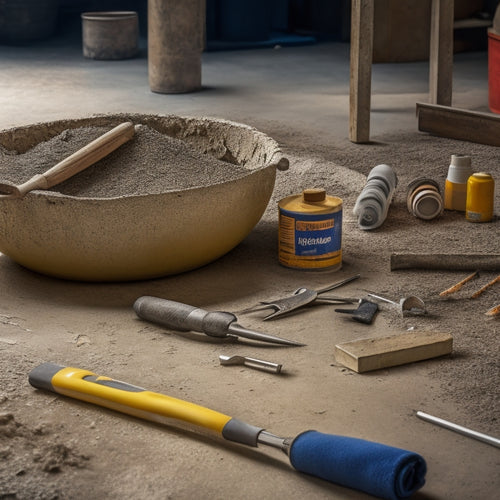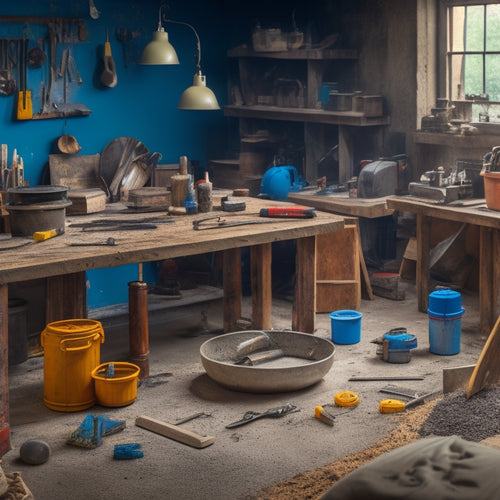
Top Tools for Cleaning Sealed Concrete Surfaces
Share
You'll need a mix of specialized tools and gentle techniques to effectively clean your sealed concrete surfaces without damaging the sealant or underlying concrete. For daily maintenance, microfiber mops, soft-bristle brooms, and eco-friendly cleaning solutions are essentials. For tougher jobs, electric or gas-powered pressure washers, ride-on scrubbers, and orbital scrubbers can be employed. When it comes to removing stains, pH-balanced, emulsifying, or enzymatic solutions are your best bet. By incorporating these top tools into your cleaning routine, you'll be well on your way to achieving a pristine, well-maintained sealed concrete surface, and there's more to explore to take your cleaning game to the next level.
Key Takeaways
- Microfiber mops are recommended for gentle cleaning and dirt absorption on sealed concrete surfaces.
- Electric or gas-powered pressure washers with 1,000-4,000 PSI are ideal for cleaning small to large areas of sealed concrete.
- Soft-bristle or synthetic fiber brooms and microfiber cloths are effective for sweeping and dusting sealed concrete without scratching the sealant.
- pH-balanced, eco-friendly cleaning solutions should be used to prevent sealant breakdown and etching on sealed concrete surfaces.
- Ride-on scrubbers, orbital scrubbers, and high-speed polishers can be used for advanced scrubbing and polishing of sealed concrete surfaces.
Effective Mops for Sealed Concrete
When tackling sealed concrete surfaces, you'll want to arm yourself with the right mop to get the job done efficiently. The ideal mop for this task should be made from materials that effectively pick up dirt and grime without scratching the sealed surface.
Microfiber mops are a popular choice, as they're gentle on the concrete and can absorb a significant amount of dirt and water.
To guarantee a thorough cleaning, it's crucial to employ the right cleaning techniques. Start by sweeping the area to remove any debris, then mix a solution of mild detergent and warm water.
Dip your mop into the solution, wring it out thoroughly, and mop the surface in sections. Use gentle, overlapping strokes to cover the entire area, working in a pattern to maintain even coverage.
Avoid using too much water, as this can damage the sealant. For tougher stains, you can use a more aggressive cleaning solution, but be sure to test it on a small, inconspicuous area first to confirm it won't damage the surface.
Best Pressure Washers for Cleaning
Powerful pressure washers can blast away stubborn dirt and grime on sealed concrete surfaces, but not all models are created equal. You'll want to choose a pressure washer that's designed for the job, with the right features and specifications to get the job done efficiently and effectively.
When selecting a pressure washer, consider the type and its corresponding PSI (pounds per square inch) rating. Electric pressure washers are suitable for smaller areas and lighter cleaning tasks, while gas-powered models are better suited for larger areas and tougher cleaning jobs.
Here is a comparison of popular pressure washer types:
| Type | PSI Rating | Suitable For |
|---|---|---|
| Electric | 1,000-2,000 | Small areas, light cleaning |
| Gas-Powered | 2,500-4,000 | Large areas, heavy cleaning |
| Industrial-Grade | 4,000-6,000 | Heavy-duty cleaning, commercial use |
Remember to follow regular maintenance tips to extend the life of your pressure washer, including regular cleaning of the nozzle and hose, checking and replacing worn seals, and storing the unit in a dry, protected area. By choosing the right pressure washer and following proper maintenance tips, you'll be able to keep your sealed concrete surfaces clean and looking their best.
Seal-Friendly Broom and Dusting Tools
Sweeping away debris with the right broom and dusting tools is essential to maintaining a clean and well-sealed concrete surface.
You'll want to choose brooms with soft bristles or synthetic fibers that won't scratch the sealant. Look for eco-friendly options made from natural or recycled materials.
For dusting, opt for microfiber cloths or dusters with extendable handles to reach those hard-to-reach areas.
When sweeping, work in sections to prevent pushing dirt and debris around. Start from the outer edges and work your way inwards to prevent scratching the surface.
Regularly clean your broom and dusting tools to prevent dirt and debris from accumulating and being redeposited onto the surface.
As part of your maintenance tips, establish a regular cleaning schedule to prevent dirt and debris from building up.
Sweep or dust your sealed concrete surface at least once a week, or more often in high-traffic areas.
Top-Rated Concrete Cleaning Solutions
What makes a concrete cleaning solution effective? For you, it's crucial to choose a solution that can effectively remove dirt and stains without damaging the sealed surface.
Look for eco-friendly cleaners that are specifically designed for sealed concrete surfaces. These solutions typically have a pH level close to that of water, ensuring they won't break down the sealant or etch the concrete.
When selecting a cleaning solution, consider the type of stains you're dealing with. For oil-based stains, you'll need a solution that can emulsify and break down the oil. For organic stains like food or grass, an enzymatic cleaner can be effective. For tough stains, look for solutions that contain oxidizing agents like oxygen bleach or hydrogen peroxide.
Remember to always follow the manufacturer's instructions and test the solution on a small area before applying it to the entire surface.
Effective stain removal requires the right cleaning solution, so take the time to choose the best one for your specific needs. By doing so, you'll be able to maintain a clean and well-protected sealed concrete surface.
Advanced Scrubbing and Polishing Equipment
When tackling stubborn stains or restoring the shine to your sealed concrete surface, you'll likely need to graduate from manual scrubbing to more advanced equipment. This is where advanced scrubbing and polishing equipment come into play, offering more efficient and effective solutions for tough cleaning tasks.
To tackle the toughest stains and imperfections, consider the following advanced scrubbing and polishing tools:
-
Ride-on scrubbers: Ideal for large areas, these machines provide increased productivity and reduced fatigue. Look for models with adjustable scrubbing heads and variable speed controls.
-
Orbital scrubbers: These compact, walk-behind scrubbers are perfect for smaller areas and tight spaces. They offer aggressive scrubbing action without sacrificing maneuverability.
-
High-speed polishers: For a high-gloss finish, high-speed polishers are the way to go. These machines employ advanced polishing techniques, such as diamond polishing or chemical polishing, to achieve a showroom shine.
Frequently Asked Questions
How Often Should I Clean My Sealed Concrete Surface?
You should clean your sealed concrete surface regularly, ideally every 3-6 months, depending on foot traffic and exposure to dirt and stains, to maintain its appearance and prevent damage, following proper cleaning frequency and maintenance tips.
Can I Use Bleach to Clean Sealed Concrete Floors?
As you commence on a quest for a sparkling clean floor, remember that bleach can be a harsh knight, damaging your sealed concrete's armor. Instead, opt for bleach alternatives and gentle cleaning methods to maintain your surface's integrity and luster.
Are Steam Cleaners Safe for Sealed Concrete Surfaces?
When using a steam cleaner on sealed concrete, you'll reap benefits like sanitized surfaces and reduced chemical use, but make certain you follow safe cleaning methods, setting the steam to a low pressure and avoiding excessive moisture to prevent damage.
Can I Use a Regular Vacuum on Sealed Concrete Floors?
You'll want to choose the right vacuum type for sealed concrete floors, as you're not limited to just one option, but you do need to prioritize surface protection, so consider upright, canister, or handheld vacuums with soft brushes or felt wheels.
Do I Need to Reapply Sealant After Cleaning My Concrete Surface?
When you clean your sealed concrete surface, you'll need to reassess the sealant's condition; if you've used harsh cleaning methods, you may need to reapply a new coat of sealant, depending on the type and its durability.
Conclusion
You've got the right tools in your arsenal now to tackle any sealed concrete surface. From mops to pressure washers, and from brooms to advanced scrubbing equipment, you're equipped to cut through dirt and grime like a hot knife through butter. Remember, cleaning sealed concrete is a delicate balancing act, so be sure to follow manufacturer instructions and test products on a small area first. With the right tools and a little elbow grease, your sealed concrete will shine like new in no time.
Related Posts
-

Top Tools for Repairing Cracked Concrete Surfaces
When tackling a cracked concrete surface repair, you'll need the right tools to guarantee a durable fix. Start with e...
-

Concrete Foundation Building Tools for Homeowners' Success
As you start your concrete foundation building project, it is vital to have the right tools to guarantee success. You...
-

Budget-Friendly Tools for DIY Decorative Concrete Profiling
You can achieve professional-grade decorative concrete results on a budget by investing in the right combination of e...


